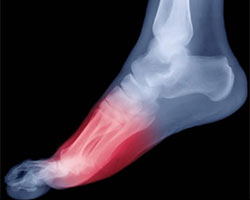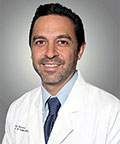- Home
- Foot & Ankle Conditions
- Pediatric Conditions
- Avascular Necrosis
Avascular Necrosis: causes, symptoms and treatment options
- Published 6/1/2018
- Last Reviewed 1/9/2024

What Is Avascular Necrosis of the foot (Freiberg's Disease)?
Avascular Necrosis (AVN), also called Freiberg's disease, osteonecrosis, or Freiberg infraction disease, is the death of bone tissue in the forefoot due to interruption of the blood supply. It’s an osteochondral condition, meaning it affects the cartilage and underlying bone in a joint.
It usually occurs in the second toe (the toe next to the big toe), but it can occur in the third or even fourth toes. It is a relatively rare musculoskeletal condition, though its complications can be quite serious. Freiberg disease in adults is possible, but it is more common in adolescents.
- What causes avascular necrosis?
- What are the symptoms of avascular necrosis?
- How is Freiberg’s disease diagnosed?
- What is Freiberg's disease treatment?
- Conservative treatment options
- Surgical Options
- Reach out to UFAI for your pediatric foot and ankle conditions
- How rare is Freiberg's disease?
- Can Freiberg's disease go away?
- Are there Freiberg infraction taping techniques?
-
ABFAS® Board Certified in Foot Surgery and Reconstructive Rearfoot and Ankle Surgery. and Director of University Foot and Ankle Institute
Dr. Bob Baravarian DPM, FACFAS is a Board-Certified Podiatric Foot and Ankle Specialist. He is an assistant clinical professor at the UCLA School of Medicine and serves as Director of University Foot and Ankle Institute.
Dr. Baravarian has been involved in athletics his entire life and played competitive tennis in high school and college. He has an interest in sports medicine, arthritis therapy, and trauma/reconstructive surgery of the foot and ankle. He is also fluent in five languages (English, French, Spanish, Farsi, and Hebrew),
-
ABFAS® Board Certified in Foot Surgery and Reconstructive Rearfoot and Ankle Surgery. and Director of University Foot and Ankle Institute
Dr. Bob Baravarian DPM, FACFAS is a Board-Certified Podiatric Foot and Ankle Specialist. He is an assistant clinical professor at the UCLA School of Medicine and serves as Director of University Foot and Ankle Institute.
Dr. Baravarian has been involved in athletics his entire life and played competitive tennis in high school and college. He has an interest in sports medicine, arthritis therapy, and trauma/reconstructive surgery of the foot and ankle. He is also fluent in five languages (English, French, Spanish, Farsi, and Hebrew),
 After 15 years of surgery fear and bad big toe joints I could hardly walk for more than 10 minutes. I have visited many Dr.s bu...Steve N.
After 15 years of surgery fear and bad big toe joints I could hardly walk for more than 10 minutes. I have visited many Dr.s bu...Steve N. Please provide handicap parkingBarry S.
Please provide handicap parkingBarry S. Dr. Justin Franson absolutely rocks! Phenomenal doctor with tons of experience. He's always professional, amicable, patient a...Manuel R.
Dr. Justin Franson absolutely rocks! Phenomenal doctor with tons of experience. He's always professional, amicable, patient a...Manuel R. Dr. Ambibola Johnson is awesome!Laurie S.
Dr. Ambibola Johnson is awesome!Laurie S. I appreciate the care and timeliness of all my appointments I’ve had at UFAI. Gray, Lydia and the staff all are wonderful. Lydi...Edelmira G.
I appreciate the care and timeliness of all my appointments I’ve had at UFAI. Gray, Lydia and the staff all are wonderful. Lydi...Edelmira G. Very greatfull for the doctor and stuffJesus M.
Very greatfull for the doctor and stuffJesus M. Doctor was very caringBrigitte S.
Doctor was very caringBrigitte S. Everyone is very nice and efficient-
Everyone is very nice and efficient-
Especially Dr Kelman. He takes very good care of me!!Claudia K. Great costumer service.
Great costumer service.
Prompt and efficientDean W. No . I’m pleased with the care .Michael P.
No . I’m pleased with the care .Michael P. Appreciate the professionalism and expertise, as well as the caring.Stella G.
Appreciate the professionalism and expertise, as well as the caring.Stella G. Yes- I highly recommend Dr Bob Baravarian at University Foot & Ankle Institute for bunion surgery. He is an excellent surgeon. ...Lisa L.
Yes- I highly recommend Dr Bob Baravarian at University Foot & Ankle Institute for bunion surgery. He is an excellent surgeon. ...Lisa L.
